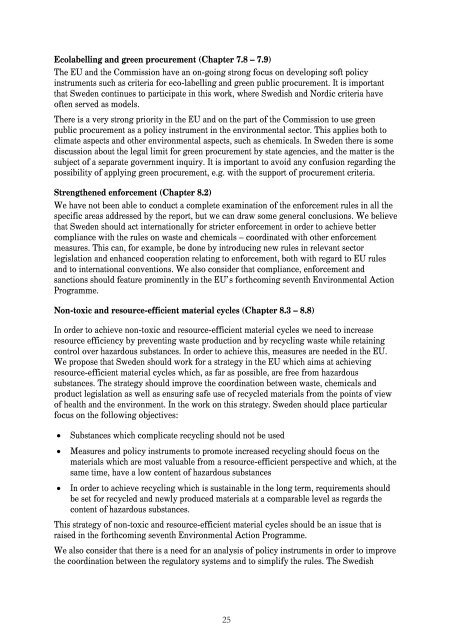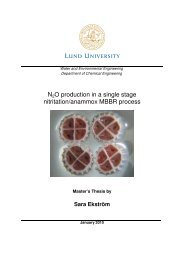Bättre EU-regler för en giftfri miljö - Kemikalieinspektionen
Bättre EU-regler för en giftfri miljö - Kemikalieinspektionen
Bättre EU-regler för en giftfri miljö - Kemikalieinspektionen
You also want an ePaper? Increase the reach of your titles
YUMPU automatically turns print PDFs into web optimized ePapers that Google loves.
Ecolabelling and gre<strong>en</strong> procurem<strong>en</strong>t (Chapter 7.8 – 7.9)<br />
The <strong>EU</strong> and the Commission have an on-going strong focus on developing soft policy<br />
instrum<strong>en</strong>ts such as criteria for eco-labelling and gre<strong>en</strong> public procurem<strong>en</strong>t. It is important<br />
that Swed<strong>en</strong> continues to participate in this work, where Swedish and Nordic criteria have<br />
oft<strong>en</strong> served as models.<br />
There is a very strong priority in the <strong>EU</strong> and on the part of the Commission to use gre<strong>en</strong><br />
public procurem<strong>en</strong>t as a policy instrum<strong>en</strong>t in the <strong>en</strong>vironm<strong>en</strong>tal sector. This applies both to<br />
climate aspects and other <strong>en</strong>vironm<strong>en</strong>tal aspects, such as chemicals. In Swed<strong>en</strong> there is some<br />
discussion about the legal limit for gre<strong>en</strong> procurem<strong>en</strong>t by state ag<strong>en</strong>cies, and the matter is the<br />
subject of a separate governm<strong>en</strong>t inquiry. It is important to avoid any confusion regarding the<br />
possibility of applying gre<strong>en</strong> procurem<strong>en</strong>t, e.g. with the support of procurem<strong>en</strong>t criteria.<br />
Str<strong>en</strong>gth<strong>en</strong>ed <strong>en</strong>forcem<strong>en</strong>t (Chapter 8.2)<br />
We have not be<strong>en</strong> able to conduct a complete examination of the <strong>en</strong>forcem<strong>en</strong>t rules in all the<br />
specific areas addressed by the report, but we can draw some g<strong>en</strong>eral conclusions. We believe<br />
that Swed<strong>en</strong> should act internationally for stricter <strong>en</strong>forcem<strong>en</strong>t in order to achieve better<br />
compliance with the rules on waste and chemicals – coordinated with other <strong>en</strong>forcem<strong>en</strong>t<br />
measures. This can, for example, be done by introducing new rules in relevant sector<br />
legislation and <strong>en</strong>hanced cooperation relating to <strong>en</strong>forcem<strong>en</strong>t, both with regard to <strong>EU</strong> rules<br />
and to international conv<strong>en</strong>tions. We also consider that compliance, <strong>en</strong>forcem<strong>en</strong>t and<br />
sanctions should feature promin<strong>en</strong>tly in the <strong>EU</strong>’s forthcoming sev<strong>en</strong>th Environm<strong>en</strong>tal Action<br />
Programme.<br />
Non-toxic and resource-effici<strong>en</strong>t material cycles (Chapter 8.3 – 8.8)<br />
In order to achieve non-toxic and resource-effici<strong>en</strong>t material cycles we need to increase<br />
resource effici<strong>en</strong>cy by prev<strong>en</strong>ting waste production and by recycling waste while retaining<br />
control over hazardous substances. In order to achieve this, measures are needed in the <strong>EU</strong>.<br />
We propose that Swed<strong>en</strong> should work for a strategy in the <strong>EU</strong> which aims at achieving<br />
resource-effici<strong>en</strong>t material cycles which, as far as possible, are free from hazardous<br />
substances. The strategy should improve the coordination betwe<strong>en</strong> waste, chemicals and<br />
product legislation as well as <strong>en</strong>suring safe use of recycled materials from the points of view<br />
of health and the <strong>en</strong>vironm<strong>en</strong>t. In the work on this strategy. Swed<strong>en</strong> should place particular<br />
focus on the following objectives:<br />
• Substances which complicate recycling should not be used<br />
• Measures and policy instrum<strong>en</strong>ts to promote increased recycling should focus on the<br />
materials which are most valuable from a resource-effici<strong>en</strong>t perspective and which, at the<br />
same time, have a low cont<strong>en</strong>t of hazardous substances<br />
• In order to achieve recycling which is sustainable in the long term, requirem<strong>en</strong>ts should<br />
be set for recycled and newly produced materials at a comparable level as regards the<br />
cont<strong>en</strong>t of hazardous substances.<br />
This strategy of non-toxic and resource-effici<strong>en</strong>t material cycles should be an issue that is<br />
raised in the forthcoming sev<strong>en</strong>th Environm<strong>en</strong>tal Action Programme.<br />
We also consider that there is a need for an analysis of policy instrum<strong>en</strong>ts in order to improve<br />
the coordination betwe<strong>en</strong> the regulatory systems and to simplify the rules. The Swedish<br />
25















